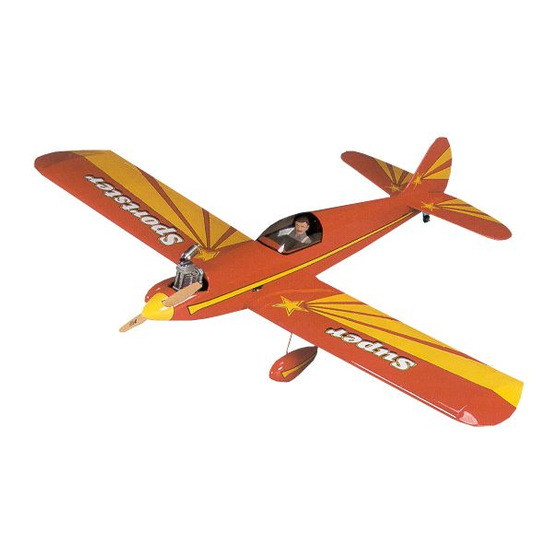GREAT PLANES Super Sportster 40 Інструкція з експлуатації - Сторінка 17
Переглянути онлайн або завантажити pdf Інструкція з експлуатації для Іграшка GREAT PLANES Super Sportster 40. GREAT PLANES Super Sportster 40 20 сторінок.

Low Rate
Aileron
3/16" [5mm] up
3/16" [5mm] down
Elevator
7/16" [11mm] up
7/16" [11mm] down
Rudder
1" [25mm] left
1" [25mm] right
These are the suggested deflection from center of the
control surface.
If you need more control movement, you should move the
clevis to a hole closer to the control surface or you can move
the rod at the servo away from the center of the servo. If you
have too much movement, do the opposite. See the
following sketches:
Moving the clevis outward on the servo arm
results in more pushrod movement.
Moving the clevis inward on the control horn
results in more throw.
Balance Your Model
Note: This section is VERY important and must NOT be
omitted! A model that is not properly balanced will be
unstable and possibly unflyable.
❏
1. The balance point (C.G.) is located 3-5/16" [84mm] back
from the leading edge of the wing against the fuselage.
Balance your Super Sportster using a Great Planes C.G.
Machine
Airplane Balancer (GPMR2400) for the most
™
accurate results. This is the balance point at which your
High Rate
3/8" [9.5mm] up
3/8" [9.5mm] down
5/8" [16mm] up
5/8" [16mm] down
1-3/16" [30mm] left
1-3/16" [30mm] right
More
movement
Less
movement
More
movement
More
throw
More
throw
model should balance for your first flights. After initial trim
flights and when you become more acquainted with your
Super Sportster, you may wish to experiment by shifting the
balance up to 1/4" [6mm] forward or backward to change its
flying characteristics. Moving the balance forward may
improve the smoothness and stability, but the model may
then require more speed for takeoff and may become more
difficult to slow for landing. Moving the balance aft makes
the model more agile with a lighter, snappier "feel" and often
improves knife-edge capabilities. In any case, please start at
the location we recommend. Do not at any time balance
your model outside the recommended range.
❏
2. With the wing attached to the fuselage, all parts of the
model installed (ready to fly), and an empty fuel tank, block
up the tail as necessary to level the stab. Lift the model at
the desired balance point, and observe the tail of the
aircraft. If the tail drops, the model is "tail heavy" and you
must add weight* to the nose to balance the model. If the
nose drops, it is "nose heavy" and you must add weight* to
the tail to balance the model.
Note: Nose weight may be easily installed by using a
"spinner weight." Tail weight may be added by using Great
Planes (GPMQ4485) "stick-on" weights.
*If possible, first attempt to balance the model by changing
the position of the receiver battery. If you are unable to
obtain good balance by doing so, then it will be necessary to
add weight to the nose or tail to achieve the proper balance
point. Remember to secure the receiver and battery after
your model has been balanced.
Balance Your Model Laterally
IMPORTANT: Do not confuse this procedure with "checking
the C.G." or "balancing the airplane fore and aft."
Now that you have the basic airplane nearly completed, this
is a good time to balance the airplane laterally (side-to-side).
Here is how to do it:
❏
1. Assemble the model in as in preparation for flight. (No
fuel is required for this procedure.)
❏
2. With the wing level, lift the model by the engine propeller
shaft and the fin post (this may require two people). Do this
several times.
❏
3. If one wing always drops when you lift the model, it means
that side is heavy. Balance the airplane by adding weight to
the opposite, lighter wing tip.
Note: An airplane that has been laterally balanced will track
better in loops and other maneuvers.
17
